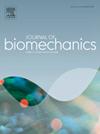Contribution of whole-body momentum regulation towards jump height differences in two-foot running jumps with and without a basketball
IF 2.4
3区 医学
Q3 BIOPHYSICS
引用次数: 0
Abstract
Two-foot running jumps (TFRJs) are frequently performed by basketball players with or without a basketball, but the effects of ball control on jump performance and whole-body momentum regulation are unknown. We examined the differences between TFRJ with and without a ball in initial and takeoff center of mass (COM) vertical velocities and net upward impulse. Fifteen male and six female recreational to college-level basketball players performed TFRJs with and without ball towards an adjustable hoop. Jump height was computed as vertical jump displacement from takeoff COM upward velocity. Linear mixed models were used to compare jump height and contributing variables across conditions. Group results revealed lower jump heights, lower net upward impulses, and lower second leg upward impulses (each comparison p < 0.001) during TFRJs with versus without a ball. Within-participant results revealed a mixture of contributing factors to lower jump heights across participants, and three did not exhibit significant differences in jump heights across jumping conditions. Compared to TFRJs without ball, eighteen participants had lower jump heights during TFRJ with a ball, fourteen participants generated less net upward impulse due to less first leg or second leg upward impulse generation, or an increase in the downward impulse due to bodyweight (via increased ground contact duration and/or lower average upward ground reaction forces), and five participants had faster initial downward COM velocity due to differences in the running approach during TFRJ with a ball. These participant-specific contributions to jump height during differing TFRJ tasks provide meaningful motor control contexts to inform coaching.
全身动量调节对带和不带篮球两尺跑跳跳跃高度差异的贡献
两尺跑跳(TFRJs)是篮球运动员在带篮球或不带篮球时经常进行的动作,但控球对跳跳表现和全身动量调节的影响尚不清楚。我们研究了有球和没有球的TFRJ在初始和起飞质心(COM)垂直速度和净向上冲量方面的差异。15名男性和6名女性休闲到大学水平的篮球运动员对一个可调节的篮筐进行了有球和无球的tfrj。跳跃高度计算为垂直跳跃位移,从起飞COM向上的速度。线性混合模型用于比较不同条件下的跳跃高度和贡献变量。组结果显示跳高较低,净向上冲力较低,第二腿向上冲力较低(每次比较p <;0.001)在有球和没有球的tfrj中。参与者内部的结果显示,导致参与者跳高较低的因素是混合的,三个参与者在不同的跳跃条件下的跳高没有显着差异。与不带球的TFRJ相比,18名参与者在有球的TFRJ中跳跃高度较低,14名参与者由于第一腿或第二腿产生的向上冲力较少,或由于体重(通过增加与地面接触的时间和/或较低的平均向上地面反作用力)而产生的向下冲力增加,因此产生的净向上冲力较少。由于跑动方式的不同,5名参与者在带球的TFRJ中有更快的初始向下COM速度。这些参与者在不同TFRJ任务中对跳跃高度的特定贡献为指导提供了有意义的运动控制背景。
本文章由计算机程序翻译,如有差异,请以英文原文为准。
求助全文
约1分钟内获得全文
求助全文
来源期刊

Journal of biomechanics
生物-工程:生物医学
CiteScore
5.10
自引率
4.20%
发文量
345
审稿时长
1 months
期刊介绍:
The Journal of Biomechanics publishes reports of original and substantial findings using the principles of mechanics to explore biological problems. Analytical, as well as experimental papers may be submitted, and the journal accepts original articles, surveys and perspective articles (usually by Editorial invitation only), book reviews and letters to the Editor. The criteria for acceptance of manuscripts include excellence, novelty, significance, clarity, conciseness and interest to the readership.
Papers published in the journal may cover a wide range of topics in biomechanics, including, but not limited to:
-Fundamental Topics - Biomechanics of the musculoskeletal, cardiovascular, and respiratory systems, mechanics of hard and soft tissues, biofluid mechanics, mechanics of prostheses and implant-tissue interfaces, mechanics of cells.
-Cardiovascular and Respiratory Biomechanics - Mechanics of blood-flow, air-flow, mechanics of the soft tissues, flow-tissue or flow-prosthesis interactions.
-Cell Biomechanics - Biomechanic analyses of cells, membranes and sub-cellular structures; the relationship of the mechanical environment to cell and tissue response.
-Dental Biomechanics - Design and analysis of dental tissues and prostheses, mechanics of chewing.
-Functional Tissue Engineering - The role of biomechanical factors in engineered tissue replacements and regenerative medicine.
-Injury Biomechanics - Mechanics of impact and trauma, dynamics of man-machine interaction.
-Molecular Biomechanics - Mechanical analyses of biomolecules.
-Orthopedic Biomechanics - Mechanics of fracture and fracture fixation, mechanics of implants and implant fixation, mechanics of bones and joints, wear of natural and artificial joints.
-Rehabilitation Biomechanics - Analyses of gait, mechanics of prosthetics and orthotics.
-Sports Biomechanics - Mechanical analyses of sports performance.
 求助内容:
求助内容: 应助结果提醒方式:
应助结果提醒方式:


